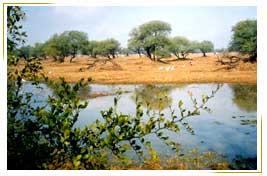 The Bharatpur Bird Sanctuary has a distinguished status. It is specially acknowledged for its migratory birds coming from all corners of the globe including Siberia. As per ornithological records, over 350 species of birds are seen breeding, nesting and fishing in the Ghana swallow lakes in an area of 29 sq km. It is a bird lover’s paradise constituting one of the most important heronries in the world. The Bharatpur Bird Sanctuary has a distinguished status. It is specially acknowledged for its migratory birds coming from all corners of the globe including Siberia. As per ornithological records, over 350 species of birds are seen breeding, nesting and fishing in the Ghana swallow lakes in an area of 29 sq km. It is a bird lover’s paradise constituting one of the most important heronries in the world.
The Keoladeo Ghana National Park or the Bharatpur Bird Sanctuary lies between the historic cities of Agra and Jaipur. It is situated in the state of Rajasthan. The name ‘Keoladeo’ is derived from the name of an ancient Hindu temple devoted to Lord Shiva in the sanctuary’s central zone while the Hindi term 'Ghana' implies dense, thick areas of forest cover.
The Bharatpur Sanctuary is home to a variety of bird species from across the globe. About 380 species of birds are found in this 29 sq km stretch, of which approximately 10 sq km consists of marshes and bogs. The rest of the area comprises scrublands, grasslands and more than 44,000 trees that are used for nesting by birds each year. This spectacular fusion of marshes, woodland and flora found represents the density and diversity of the region’s forest cover.
The Bharatpur Sanctuary is one of the most inviting destinations in the world for ornithologists, amateurs and nature lovers for some 377 different species have been spotted here. Various species of indigenous water birds, waterside birds, migratory water birds, land migratory birds, and domestic land species inhabit this area, and there are approximately 56 different families of birds, of which the Passeriformes (156 species) and Charadriformes (56 species) dominate. One-third of birds at Bharatpur are migrants, many of which spend their winters here before returning to their breeding grounds in the Arctic and Central Asia.
This one-of-a-kind bird sanctuary has a special history. The Maharaja of Bharatpur is credited for its creation in 1890, even though conservation was the last thing on his mind. He got a large area enclosed with embankments and further divided it with earthen dams called ’bunds’ creating a large number of marshes and lakes. Thus, Bharatpur is mainly an artificial creation. The government banned the indiscriminate shooting of birds in 1965. The area was declared a national park in 1982, and accepted as a World Heritage Site in 1985.
The most popular bird among tourists and ornithologists is the Siberian Crane. According to experts, the Siberian Crane is known to travel distances of up to 6,500 km migrating from the Ob River basin region in the Aral Mountains in Siberia. Conservationists are working hard to protect this fast disappearing species. Apart from Feredunkenar in Iran, Bharatpur Sanctuary is the only place where the Siberian crane migrates. The cranes arrive in December and stay until early March. According to ornithologists, unlike its Indian counterpart the Siberian crane feeds on Cypress Rotents grass (an underground aquatic root). An intriguing fact is that though Siberian cranes have a mixed diet of vegetation, fish and other small creatures back home, they adopt a vegetarian diet during their stay in India. they react to intruders with spectacular displays and loud cries.
Other migratory birds at Bharatpur include big birds like Dalmatian pelicans, which are two meters in length, and minute ones like the Siberian leaf warbler, which is merely the size of our index finger! Several other species of cranes-corcomorants, egrets, darters, herons, storks, geese, ducks, eagles, hawks, shanks, stints, wagtails, wheatears, flycatchers, buntings, larks, spoonbills, kingfishers, owls and pipits-also make Bharatpur their temporary abode.
Bharatpur heronry is one of its kind and bustles with zealous activity. The production of chicks during the breeding season is put at about 30,000. This avian kingdom also hosts mammalian species like nilgai, sambhar, chital, black bucks, jungle cat and the wild boar. The large rock python (which is spotted at Python Point beyond Keoladeo temple) as well as its nemesis, the mongoose, are found in appreciable numbers. However, spotting a duel between the two is purely a matter of chance.
The mode of transport for getting around the sanctuary is a bicycle. Cycle-rickshaws may also be hired. Boats are available for hire from the ticket checkpoint. Boating is an excellent idea for getting around the Keoladeo Lake and observing the birds at close quarters.
During summers (April-June), the temperature ranges from 38°C to 45°C. The onset of monsoon (July-August) lowers the temperature to about 27°C. Winter (October-March) season peaks after Christmas with temperatures falling below 10°C. Ground fog in the winter persists rather erratically on unspecified periods in January.
|


